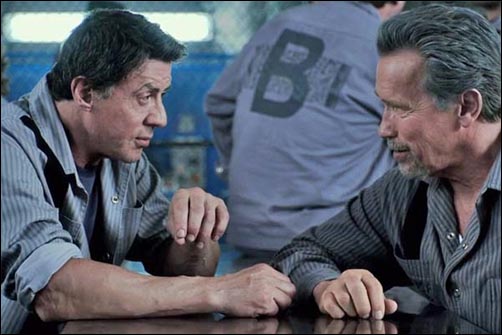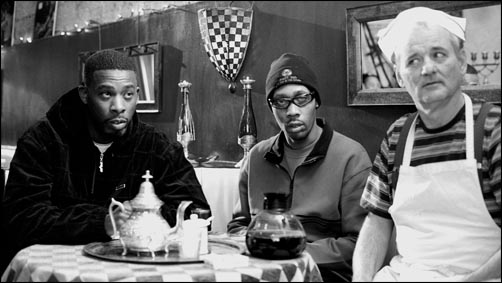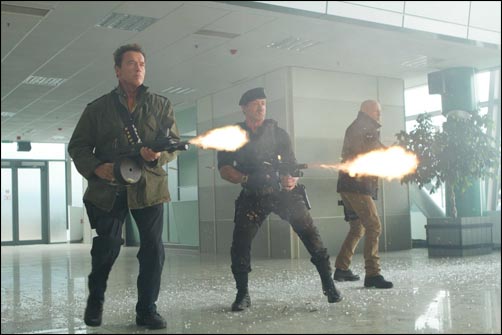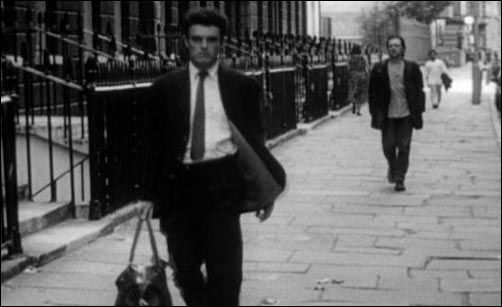
When The Expendables (2010) was released, there was much trumpeting of how both Sylvester Stallone and Arnold Schwarzenegger, stalwarts of 1980s action movies, would come together on screen. It was going to be big; it was going to be iconic. The result, however, was a single scene in a very disappointing film. They appeared together once more in The Expendables 2 (2012), garnering plenty of screen time, but Schwarzenegger was still mostly incidental. Now, in Escape Plan (2003, 115 mins) the double billing actually sees the two both play main characters in an action movie. This could have been that iconic meeting that The Expendables promised. Alas, it’s just another meeting.
Stallone plays Ray Breslin, a man who, for his own hokey reasons, makes his money by being imprisoned and then escaping in order to point out security flaws. He has literally written the book on the subject. When the movie opens we see his skill in this domain, first breaking out from a high security prison and then recounting his escape (for the audience’s benefit) to the prison’s warden in all its convoluted, improbable glory. After that, an offer comes in that would see him enter another prison, this one off the grid, and in an unknown location. His fee is double the going rate, and he accepts.
Of course, this is a trap. Someone somewhere actually wants Breslin imprisoned. And the prison, we learn, has its design (all glass cells and no natural light) in the flaws pointed out by Breslin’s book; it should therefore be impossible to escape from. Thus Escape Plan has its premise, and Stallone quickly finds an ally in Schwarzenegger’s Emil Rottmayer. If these two are aligned, antagonism comes by way of Warden Hobbes (Jim Caviezel) and sadistic prison guard Drake (Vinnie Jones). What follows is a series of prison riots and reconnaissance missions as Breslin gets the measure of his new prison and works out how to escape, making use of the objects, skills, and flaws in the system that he uncovers.
With names like Schwarzenegger, Stallone, and Jones attached, expectations aren’t high but the movie is paced well enough and the majority of scenes come across as functional. Certainly, for all the hyperbole on the film’s two stars, the direction isn’t in awe of them. While this can be good, as story should ultimately go before the cast, it somehow feels as if more could have been made of the pairing. Not so much in the characterisation (that was always going to be thin) but in the imagination around how they are filmed. What action there was felt unmemorable. Certainly Schwarzenegger’s most memorable moment would be a scene where he rants, insanely, in his native language. Beyond that, it’s a string of limp one-liners and crazy smiles.
For all the plot and action it would at least appear as if the film has its basis in matters more philosophical. The notion of the panopticon, a prison where all captives are under permanent supervision (or at least have no way of knowing if Big Brother’s eye is on them) is a direct lift from the work of Jeremy Bentham, albeit modernised to suit contemporary technology. But a warden called Hobbes brings to mind Thomas Hobbes, who in his Leviathan wrote of the social contract. Breslin, in Escape Plan, willingly secedes from civil society and therefore finds himself in a prison that bears much in relation to a world outside the Hobbesian notion of civilised society:
…no knowledge of the face of the earth; no account of time; no arts; no letters; no society; and which is worst of all, continual fear, and danger of violent death; and the life of man, solitary, poor, nasty, brutish, and short.
But, given the content of the movie, it’s probably best not to read too deep into any message it may wish to deliver. It’s a foregone conclusion that Breslin is going to escape this inescapable prison and therefore consideration need only be given to how he plans to do it. Some elements are logical, based on observation and timings; while others, although not stretching credulity, are convenient. Sometimes, instead of knowledge, escape can be about relationships and, in that respect, crucial support comes from Dr. Kyrie (Sam Neill) and some of the inmates who riot to create distractions or take on particular favours.
At the end of the day, a movie like Escape Plan is never going to be anything other than sheer escapism and its two hours whizz by without ever seeming to drag. It has its questionable moments (e.g. Hobbes shooting a prisoner when keeping him alive is the profitable option) but works well enough as a vehicle for two movie tough guys, once standalone action heroes, to work together under a double billing. Given their advancing years, it had to happen at some point, although it doesn’t quite carry the hype that, say, Heat (1995) did in pairing Al Pacino and Robert De Niro on screen for the first time. Perhaps because in Heat, the two stars worked against each other and the question was which would come out on top. Or perhaps because Stallone and Schwarzenegger are no longer the draw they once were. Either way, while it’s fun to see them work together, it’s hard not to think a better movie could have packed more of a punch.






